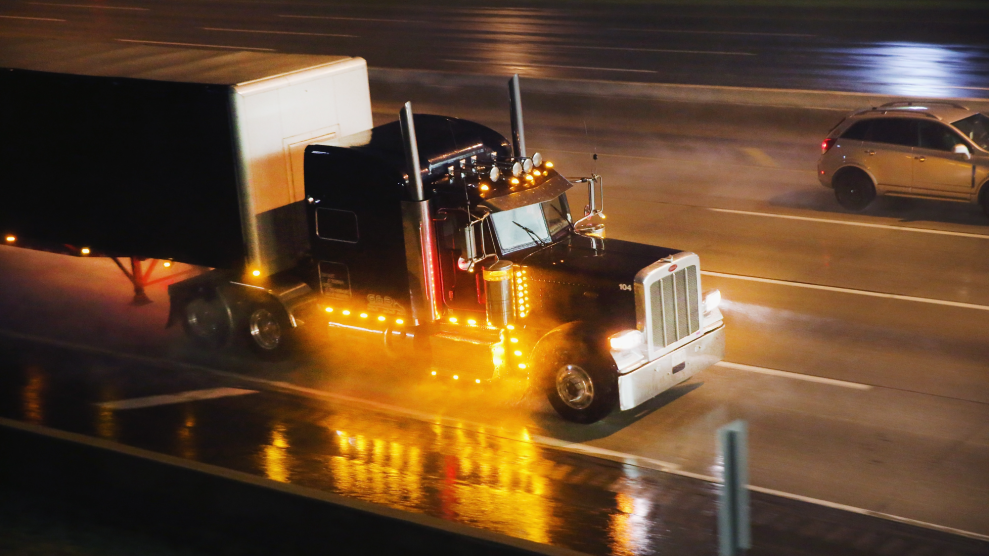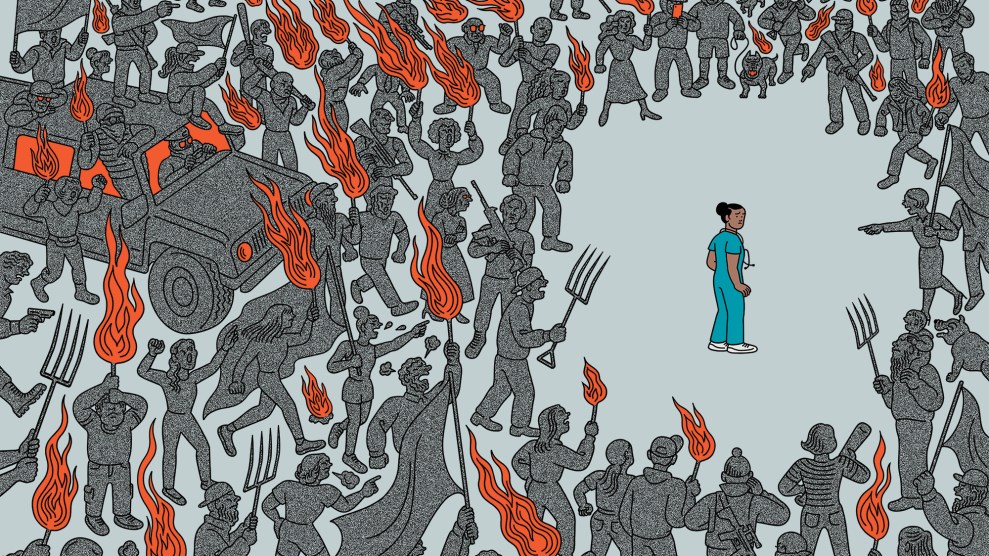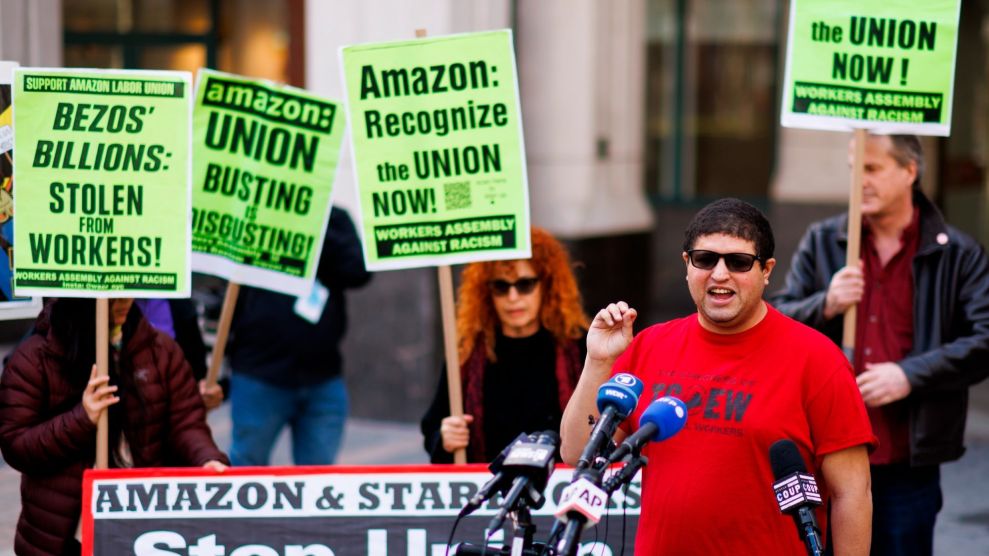
A truck driver navigates a rain-covered highway on the outskirts of Chicago in Hinsdale, Illinois.Scott Olson/Getty
The coronavirus pandemic has ushered in a new era of workplace surveillance that will extend well beyond our current crisis. Companies are increasingly monitoring employees who work from home, citing worries about security concerns or the need to boost employee productivity. In Amazon warehouses and UPS delivery trucks, surveillance technologies are being built into workplace infrastructure to monitor workers’ every move. In many industries, employers can easily access phone calls, texts, browser histories, emails, and even GPS locations with very little effort.
These exploitative surveillance practices are rooted in a historical mistrust of workers, especially low-wage workers, that can arguably be traced back to slavery and the exploitative “scientific management” practices that emerged from it, as bosses became obsessed with tracking workers’ every move to maximize productivity and profit. Earlier forms of surveillance, like in the 19th century when companies hired Pinkerton private detectives to spy on workers, required a lot of labor. But modern technological advancements mean that the cost of surveillance today is very low. Contemporary workplace surveillance is often conducted under the pretense of enhancing workers’ productivity, minimizing distractions, or improving their health and wellbeing.
Nowhere is this new surveillance regime more apparent than in the trucking industry. Often called the “lifeblood” of the US economy, the trucking sector is valued at close to a trillion dollars. As Karen Levy writes in her new book, Data Driven: Truckers, Technology, and the New Workplace Surveillance, truckers have long valued their industry’s culture of autonomy. But as new digital technologies develop, truck drivers are being increasingly watched as they do their jobs, a change that has significantly affected the average trucker’s autonomy on the road. Federal law now requires most workers to purchase and install digital trackers that record information about their movements and behavior, enabling extra monitoring by their employers and third-party companies.
These surveillance technologies are designed to solve the persistent issue of driver fatigue by restricting the number of hours truckers spend on the road, but as Levy writes, they’ve also eroded the culture of independence and freedom that truckers value—and paradoxically, they’ve made the roads less safe. I called Levy, an associate professor in the Department of Information Science at Cornell University, to learn more about what the trucking industry tells us about the future of surveillance, and about how we can both protect the public interest and uphold the dignity of workers in the digital age.
Data Driven is a great title. What inspired you to write the book?
It used to be called The Automation of Compliance, and one of my friends very gently said to me, “Karen, that title is terrible.” And I was like, yeah, okay. I think the title is better now.
But why did I write this? My training is in law and sociology, and my research interest has always been in rules and digital enforcement, and what happens when we take a rule that is out in the world and decide to start enforcing it using technology. How does it affect power dynamics within different professions and industries, including trucking? I wanted to explore what it looks like when workers find themselves confronted with systems that are collecting data about them. How does that change how they relate to each other and to management?
And is there a reason why you chose the trucking industry in particular?
Quite frankly, it was kind of a fluke. I had just heard a story on the radio—this was in 2011—saying that truckers were really upset about a proposal for a new surveillance regulation in the United States that was going to require them to install these digital tracking devices in their trucks. These ELDs, or electronic logging devices, would be installed to make sure that they were complying with “hours of service” regulations by the federal government. These regulations would essentially cap how much truckers can drive on any given day and in any given week. These rules have been in place since the 1930s in one form or another, but what was going to be different about this new rule was that truckers would no longer use paper and pencil to log in their work times. Instead, they would be tracked digitally, and those records would be kept electronically by management.
There was a lot of concern in the industry about what this would mean for their work. Eventually, it did become mandatory in 2017. When I heard the story on the radio, I thought, “Oh, wow, that’s kind of an example of this thing I’ve been really interested in. Maybe I can learn more about this.” That very day I went to a truck stop to talk to truckers about their work and their lives. And it was great, they were so easy to talk to. I enjoyed learning about this corner of the world. It’s a huge industry that touches my life and everyone’s life in so many ways, but it wasn’t something I had ever really thought much about. So I was kind of hooked as soon as I started talking to them.
Tell me more about the state of trucking today. What are the biggest challenges facing truckers?
By far the biggest challenge is that truckers are overworked and underpaid. In long-haul trucking, in the 1980s, wages used to be about $110,000 in today’s dollars. Now they’re about $47,000. Over the past 40 years, wages have completely plummeted and have not bounced back very much at all. They work lots and lots of unpaid hours. Trucking is mostly paid by the mile. That means that they’re not paid when they’re doing things like waiting at terminals to load products or unloading as they’re doing truck inspections, or when they’re taking breaks that are required by the law. There are all kinds of other things that are really important in the work of being a truck driver that don’t involve driving, and those things are usually uncompensated. They’re tired and they’re incentivized to just keep going because that’s how they make money.
But the other thing that often gets discussed as a challenge in the industry is what is frequently referred to as the “labor shortage,” that trucking companies can’t hire enough truck drivers. The turnover rate in trucking in a large firm is about 100 percent a year. Which is crazy to think about, right? However, truckers will very quickly tell you that the problem is not a labor shortage—there are plenty of people who are qualified to drive trucks. The problem is what you could call a wage shortage—that truckers aren’t being paid the money they deserve for doing this very dangerous but important work.
In the book, you trace this back to economic deregulation in the 1980s, which created a race to the bottom in terms of wages. Could you explain how this wage shortage relates to deregulation?
Absolutely. Trucking in the United States was deregulated in the early 1980s. Before that time, the federal government created barriers to entry for the industry, capped the number of companies that were licensed to drive trucks, and set standard freight rates. Companies weren’t that competitive with one another because they all had to charge the same rates. That changed with deregulation, which created a pure market and a big race to the bottom within the industry, in terms of companies becoming much more competitive with one another. The working conditions plummeted, salaries tanked, and conditions in trucking became much more unsafe and unhealthier for drivers. It was already a difficult job, but it became all the more so.
And what kinds of surveillance are truckers being subjected to today?
Truckers are kind of under the eye of everyone all at once. The electronic logging device, the ELD, collects data about where truckers are and where they’re moving, for the government to inspect. The systems also often collect information like how fast they’re changing lanes, how hard they’re braking, how much fuel they’re using, whether they’re checking their mirrors often enough, are their eyelids fluttering too much, indicating they need sleep—this information is really useful to truckers’ employers.
It also provides a scaffolding for other kinds of surveillance. Companies buy logging devices that also have the capability of tracking a whole bunch of super fine-grained stuff about what truckers are doing. Insurers are always really interested in data like this just because it gives them much more detailed information about what drivers are doing and how they’re behaving. They can potentially use data to create better predictive models that help them set financial rates and generate profit.
That’s one thing. Another thing companies sometimes do is use data from electronic logging devices to try to sell truckers parking spaces. A common thing that truckers have started to do is pay ahead to reserve a parking space at a truck stop. Using this electronic logging device data on where all these truckers are across the country, companies that want to sell that real estate have an easier time doing it because they have information from electronic logging devices that can indicate available parking spots.
Why exactly are these methods so unpopular with truckers? Aren’t they supposedly meant to address workplace problems like trucker fatigue and overworking?
Good question. There are about 2 million truck drivers and a diversity of views between them, but by and large, I would say they’ve been unpopular because it doesn’t really address what they see as the root of the problem, which is an underpayment problem. It also facilitates much broader performance monitoring and surveillance practices from companies that don’t end up helping drivers all that much.
And a lot of it is cultural. If you talk to truckers, these surveillance devices send a message to them: “We don’t trust you anymore.” They’ve prized their job in the trucking industry for its very strong culture of autonomy, and these devices really fly in the face of the way truckers think about themselves, their work, and their lifestyle.
Why has the federal government turned to digital monitoring instead of actually addressing the challenges truckers face by restructuring pay and reducing incentives to overwork?
Quite honestly, I think it’s because it’s easier. It doesn’t take as much political will. It’s very often the case that we turn to technology as a policy solution, as a Band-Aid, to try to fix a very difficult social or economic or political problem rather than addressing the root cause. Oftentimes policymakers will tend to find a way that’s palatable, like digital monitoring, because it’s a way to address this overworking problem in trucking without addressing the reasons that trigger the overworking. The pay structure, and the fact that truckers are exempt from the Fair Labor Standards Act, take more political will to change. Digital monitoring doesn’t disrupt the power structure in the industry, and it’s impacting the people who have the least power in the industry: the truck drivers. More meaningful reform would address the root causes.
Large trucks are involved in quite a few fatal crashes, and I think naturally, truckers care about both their own safety and the safety of the people around them on the road. Have they talked to you about how they might go about balancing public safety with preserving their dignity and autonomy on the road?
Yeah, this is such a good question. I think it might be very reasonable if we thought that, okay, safety is obviously really important, and some degree of worker monitoring is necessary to ensure public safety. But what’s really striking, in this case, is that it doesn’t actually come down to being about safety versus privacy, because electronic monitoring leads to less safe roads.
There are a couple of reasons this happens. One of them is that it drives old hands out of the industry. In talking to truckers, those who resist most strongly against surveillance technology are older truckers who have been driving for decades, who did not get their Commercial Driver’s License just yesterday, who have millions of safe miles under their belt. The technology, in many ways, is an affront to those drivers in a way it isn’t to, say, an 18-year-old who just got their CDL. And when it comes to safety, the drivers who you actually want to be driving next to on the highway are the folks who’ve been doing it the longest, right?
The studies that we have on the rollout of electronic monitoring and trucking show that truck crashes increased after the mandate. Truck crash fatalities actually hit a 30-year high the year they were introduced, even though the fatality rate went down for passenger cars. There have also been a bunch more citations for unsafe driving and speeding. Truckers will tell you that they feel way more pressure when they’re being monitored than when they’re not. If you tell people that because of these electronic surveillance devices, you now have less flexibility about how long you can drive and a very hard deadline to follow, you have to get from point A to point B in no more than 2 hours, what do you think is going to happen? What they will do is speed.
You refer to truckers as “canaries in the coal mine” when it comes to digital surveillance. Can you compare what’s happening in the trucking industry to other workplaces?
Yes, I think we definitely see the proliferation of quantification and digital tracking across a whole range of workplaces: in retail, in warehouses, in the financial sector, in education, in professions like law and medicine—really all over the place across not only low-wage work but also increasingly, in more professionalized settings. In some sense, trucking is this piece of the broader whole.
As work has become more distributed and hybridized during the pandemic, managers get anxious about whether employees working from home are really working. Often, a lot of managers are turning to performance management software, which is really easy to come by and is built into a lot of existing office work products, to track more about what workers are doing. I think that’s just going to become a feature of work going forward for a long time. And there are a lot of good questions about whether those types of measurement systems are measuring the right things, or whether they’re measuring things like how many emails you send or something, which is maybe not the greatest indicator of whether the work you’re doing is super worthwhile.
You write that the “future of work” is seen in either “dreamy or dystopian terms.” It’s a term that has been widely adopted by pundits to describe either a future where workers have more time for pleasure and leisure, or a darker alternative where workers are watched all the time, monitored and optimized for greater productivity purposes. How does your book fit into the conversation around the future of work?
Often, the discourse on the future of work, when it comes to increasing technology, is about how many people are going to lose their jobs when the robots take over. That’s a very common framing, and I think it’s very limited. I talk about this in the book—this point of view obviously gets at something real, which is the threat of unemployment, definitely something to worry about. But it also is a little bit reductive because oftentimes, the existing technology is not adequate to actually replace people at their work.
It also suggests that the only thing we should care about is how many jobs people have. Truckers’ experience with workplace surveillance can help us to understand that it’s not just about whether someone has a job; it’s whether that job has dignity. It’s whether that worker has a high-quality job. Trucking has been a job that has, even though it’s a very difficult and dangerous job, one that people have been very proud of for a very long time. And when you look at the way surveillance technology is deployed in the industry, you see how it just chips away at that pride in very real ways. It really does reduce the dignity that workers feel and what they’re able to accomplish with their bodies, the decisions that they’re able to make when they’re subjected to invasive and rigid surveillance tech at work that doesn’t account for the way humans actually work, live, and conduct themselves. So I’d like to see the conversation about the future of work and about automation more explicitly account for the fact that, sure, we should care about how many jobs people have, but also about whether they’re good jobs.
This interview has been edited and condensed.
Update, December 6: This story has been updated to clarify Karen Levy’s comments about the kinds of data the government collects from ELDs.











